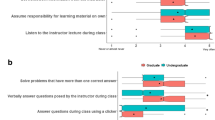Conclusion
The peer teaching experience can be an informative and most rewarding experience for the science methods student but only if it is well organized and carried out in a conscientious manner. The students can gain valuable insights into the planning, teaching, and evaluation of different science teaching strategies, which could serve them well in their future teaching profession.
Similar content being viewed by others
References
Allen, D., & Clark, R. (1967). Microteaching: Its rationale.High School Journal, 51(2), 75–79.
Arbogast, G. W., & Kizer, D. L. (1988). Evaluating instruction: An essential link in developing teaching skills.Physical Educator, 45(3), 129–131.
Collette, A. T., & Chiappetta, E. L. (1989).Science instruction in the middle and secondary schools (2nd ed.). Columbus, OH: Merrill.
Hargie, W. D., & Dwyer, E. (1982). The reactions of special education teachers in microteaching: A follow-up study.Exceptional Child, 29(1), 53–56.
Hatfield, R. C. (1989).Developing a procedural model for the practice of microteaching. East Lansing, MI: Michigan State University.
Jerich, K. F. (1987).Micro-teaching as a model for teacher education preparation: Evaluating the effects of the curricular opponent, classroom instruction, within a general methods micro-teaching approach. Report from the Office of Student Teaching, Eastern Illinois University, Charleston, IL.
Joyce, B., & Weil, M. (1986).Models of Teaching (3rd ed.). Englewood Cliffs: Prentice-Hall.
Kallenbach, W., & Gall, M. (1969). Microteaching versus conventional methods in training elementary intern teachers.The Journal of Educational Research, 63(3), 136–141.
Orlich, D. C., Harder, R. J., Callahan, R. C., Kauchak, D. P., Pendergrass, R. A., Keogh, A. J., & Gibson, H. (1990).Teaching strategies: A guide to better instruction (3rd ed.). Lexington: Heath.
Rubba, P. A., & Wiesenmayer, R. L. (1984).Seven science teacher performance checklists for use in microteaching. (ERIC Document Reproduction Service No. ED 241 263)
Tobin, K. G., & Capie, W. (1982). Development of a group test of integrated science processes.Journal of Research in Science Teaching, 19(2), 133–141.
Trowbridge, L. W., & Bybee, R. W. (1990).Becoming a secondary school science teacher (5th ed.). Columbus, OH: Merrill.
Author information
Authors and Affiliations
About this article
Cite this article
Pauline, R.F. Microteaching: An integral part of a science methods class. J Sci Teacher Educ 4, 9–17 (1993). https://doi.org/10.1007/BF02628852
Issue Date:
DOI: https://doi.org/10.1007/BF02628852




